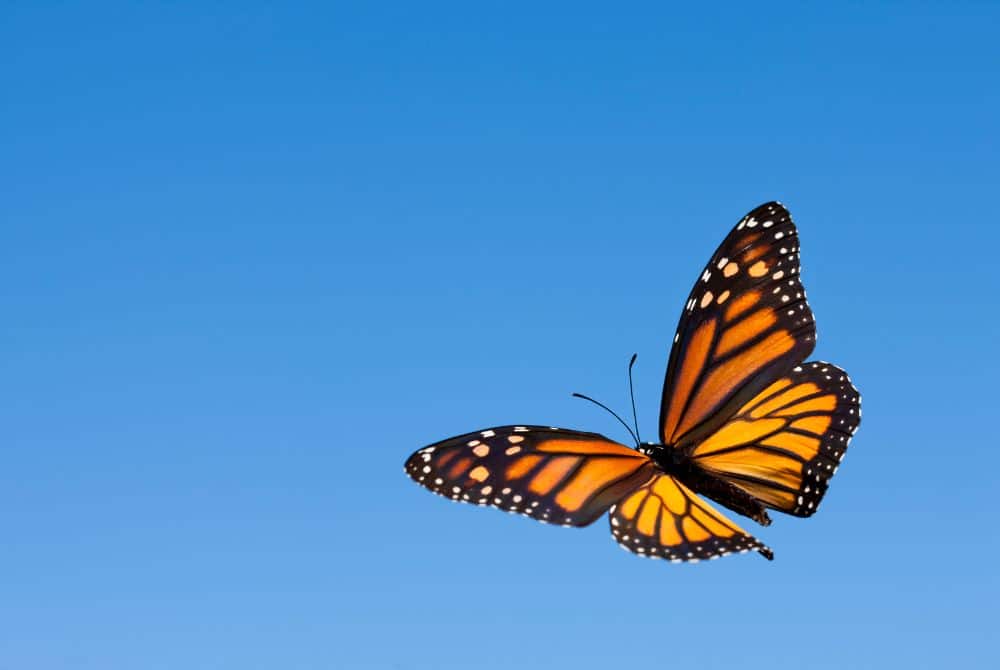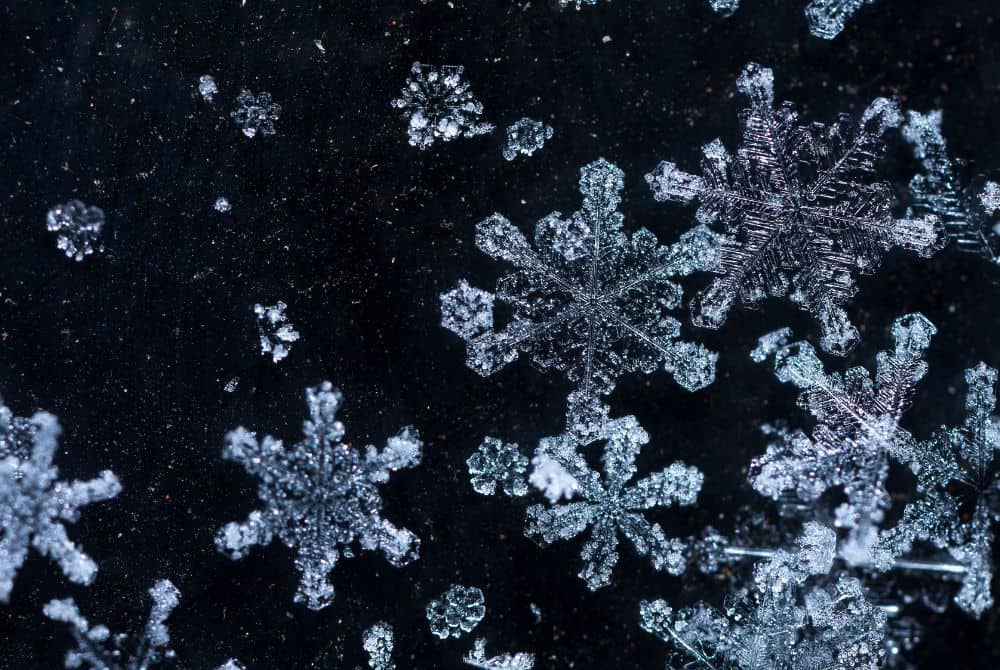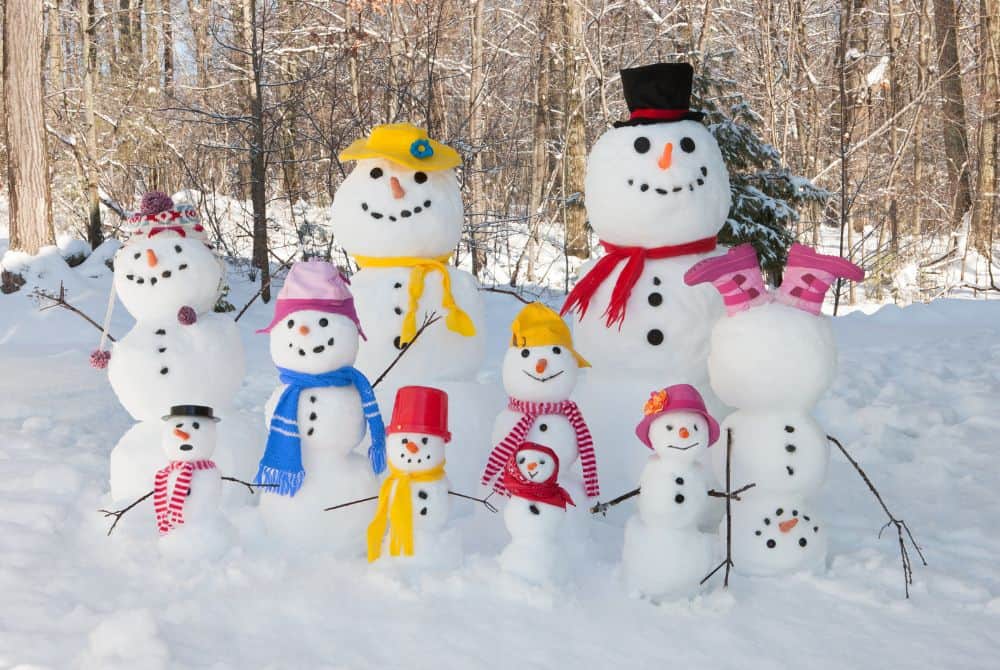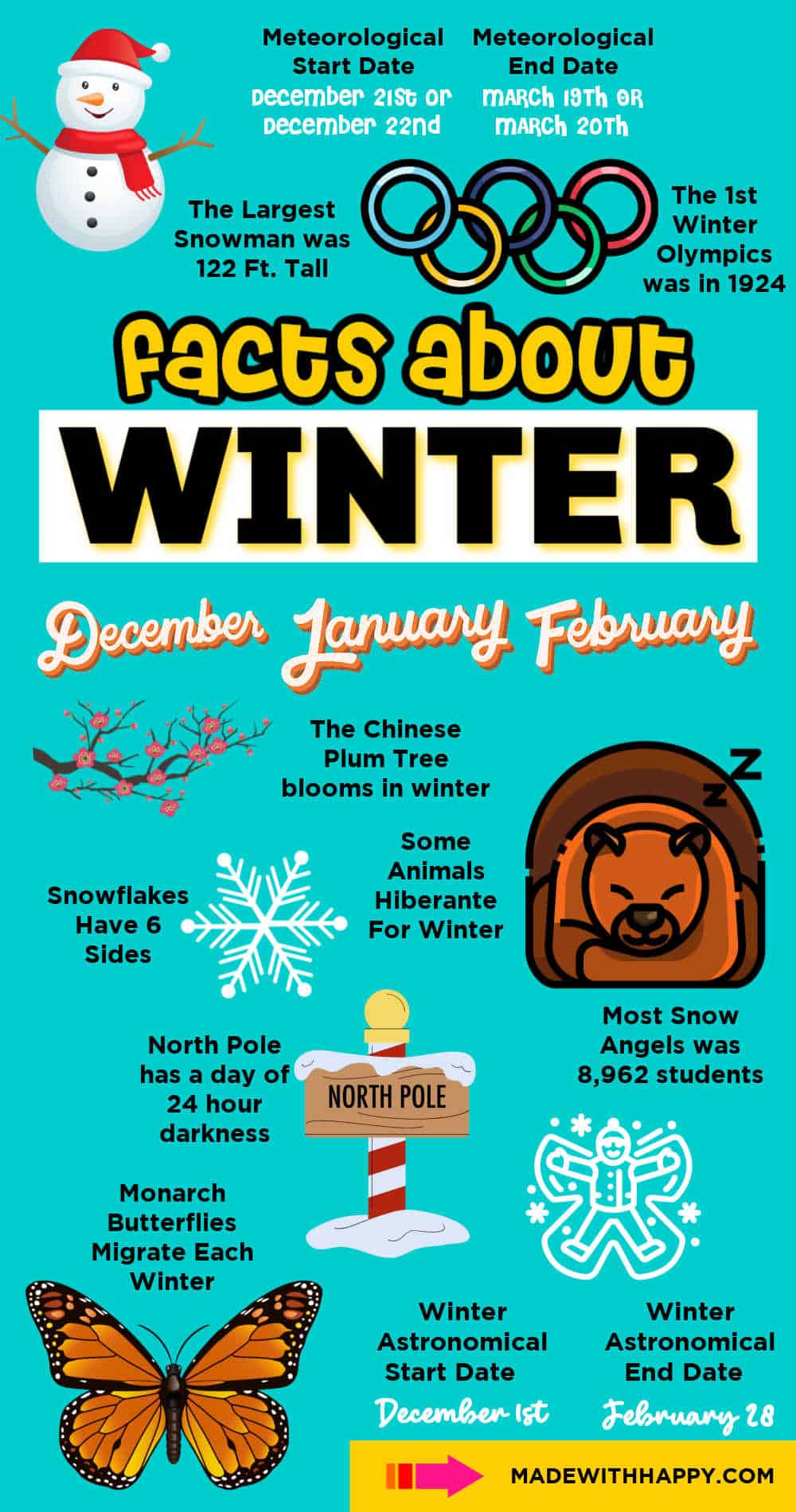Celebrate the winter season with your kids and learn lots of Fun Facts about Winter including weather, amount of sunlight, and holidays.

These Winter Facts are full of all kinds of holidays, weather fun, and a whole lot of HAPPY. Learn with us all about the winter season with these fun facts and we have some added crafts and printables that are sure to warm up the cold temperatures!

Want to save this project?
Enter your email below, and then we'll send it straight to your inbox. Plus get awesome new projects from us each week.
Winter Season
As the weather changes throughout the year, there are four different changes that occur. These four changes are called seasons. The four different seasons are Spring, Summer, Fall (or Autumn), and Winter!
Winter in both the Northern and Southern Hemispheres is caused when the Earth’s axis in that hemisphere is tilted away from the sun. Winter has nothing to do with the Earth’s orbit.
Now, let's learn all about the cold winter months and all the fun to go along with it!
Happy Winter!
Check out our 365+ Fun Facts For Kids

How Did Winter Get His Name?
The name "winter" comes from the old Germanic word that means “time of water.” This is in reference to all the snow and rain during the Winter weather.

When Does Winter Start
Winter falls in the months of December, January, and February in the Northern Hemisphere (North of the Equator). In the Southern Hemisphere, it falls in June, July, and August the summer months.
The start of winter season in the United States (Northern Hemisphere) starts on the Winter Solstice or December Solstice. On that day it is the Summer Solstice or June Solstice in the Southern Hemisphere.
Winter solstice is the shortest day of the year. Meaning it has the least amount of sunlight. Which also makes it the longest night of the year!

First Day of Winter
Each season has two different start dates. There is an astronomical start and a meteorological start.
- The astronomical start date is based on the Sun's position in relation to Earth. Winter's astronomical start date is typically on either December 21st or 22nd. It starts on June 21st or 22nd in the Southern Hemisphere.
- The meteorological start date is based on the calendar as well as the annual temperature cycle. Winter's meteorological start date is always December 1st.

When Does Winter End
The winter season typically lasts about 3 months. Based on the astronomical season winter ends on the last day of February. That is either February 28th in most years or February 29th in the leap year.
Based on the meteorological season the end date is typically March 20th or March 21st. This is dependent on the start of Spring. The start of Spring is based on the March equinox otherwise known as the Spring equinox or vernal equinox.

Winter Weather
Winter in most of the U.S. means cold weather including winter storms and blizzards. Northern Hemisphere winter results in cold temperatures which often bring snow, sleet, freezing rain, severe storms, and blizzards. Blizzards happen when strong winds cause blowing snow and whiteout conditions.
Fun Facts About Winter

- The North Pole is warmer than the South Pole.
- In Winter, the Earth is closest to the sun.
- Winter on Uranus lasts for 21 years.
- In winter, polar bears have an incredible ability to handle freezing Arctic weather.

- The Chinese plum is one of the very few plants that bloom in the winter
- There are animals that hibernate during the winter which include bears, snakes, groundhogs, skunks, hedgehogs, bumblebees, woodchucks, bats (the ones that don't choose to migrate), ground squirrels, moths, fat-tailed lemurs, and turtles.
- Winter is the coldest season of the year.

- To escape winter, animals such as birds, whales, bats, caribou, elk, and monarch butterflies migrate to warmer climates
- Canada holds a hair-freezing competition every year.
- The Arctic Circle experiences 24 hours of darkness on the day of the winter solstice.

- Some animals have the ability to turn white during the winter. These animals include the white-tailed jackrabbit, snowshoe hare, arctic fox, weasels, ptarmigan, barren-ground caribou, and ermine.
- The first Winter Olympics were in Chamonix, France (the French Alps) in 1924.
- Ice hockey, ice skating, skiing, and snowboarding are popular winter sports enjoyed around the world, with the Winter Olympics showcasing the pinnacle of these athletic pursuits.
More Interesting Facts About Winter

- The Disney movie Frozen was the first animated feature film directed by a woman, Jennifer Lee.
- There is a New Zealand insect called the weta that freezes completely solid when the temperatures drop. When the weather starts to warm up again, it thaws and goes back to doing what Weta insects do.
- According to Guinness World Records, the coldest temperature was set on July 21, 1983, in Vostok Station, Antarctica, which was -128.6°F.

- The record for the most snow angels at once was set by 8,962 students in Bismark, North Dakota in 2007.
- The fear of snow is called Chionophobia.
- In winter, the really cool thing is that the cold nights make a fantastic show called the Northern Lights, also known as the Aurora Borealis. It happens when particles from the sun meet Earth's magnetic field and create beautiful, colorful lights in the night sky, turning it into an awesome display of bright colors.
- In some places, people have turned shoveling snow into a super cool sport called shovel racing. Instead of just clearing the snow, they hop on shovels and race downhill for a fun and frosty adventure! It was once in the Winter X games even!
Facts About Snow

- No two snowflakes are alike due to the complex and unique patterns formed by ice crystals as they fall through the atmosphere.
- A snowflake can take up to two hours to fall from a cloud to the ground.
- The average speed at which a snowflake falls is about 3 miles per hour.
- There are always six sides of a snowflake.
- The largest snowflake recorded measured 15 inches wide and 8 inches thick in Fort Keogh, Montana in 1887

- The largest recorded snowman (snowwoman) was 122 feet tall.
- There are five types of snow - dry snow, moist snow, wet snow, very wet snow, and slush.
- Between 90-95 percent of snow is air.
- The most snow measured in one day was 6.3 feet of snow, in Silver Lake, Colorado in 1921.

- Winter storms happen when warm wet air meets cold dry air. Then freezing rain, ice, and snow occur.
- The Guinness Book of World Records for the most snow in one year is now held by Mount Baker, Washington in the winter of 1998-1999.
- The city of Aomori City, in northern Japan, receives the most snowfall than any other city on Earth. They receive approximately 26 feet of snow on average.
- Ten inches of snow will melt down to only 1 inch of water
Winter Holidays
There are quite a few holidays that fall in the Winter season. Especially based on the meteorological season December 21st through March 20th
December Facts

Celebrate the December holidays with joy and warmth, embracing festive traditions and creating cherished memories with family and friends!
Hanukkah Facts

Explore fascinating Facts About Hanukkah, learning about the history, traditions, and joyful celebrations that make this Festival of Lights so special!
Christmas Facts

Discover enchanting Christmas Facts, unraveling the magic behind beloved traditions, festive tales, and the spirit that makes this holiday season merry and bright!
New Years Facts

Embark on a journey of discovery with New Year Facts, unraveling fascinating insights into global celebrations, time-honored customs, and the excitement of a fresh start as well as New Year's Eve!
January Facts

Explore fascinating January facts, from historical events to unique celebrations, in this engaging collection that will spark curiosity and knowledge.
Martin Luther King Jr. Facts

Explore enlightening facts about Martin Luther King Jr., a visionary leader who championed civil rights and inspired positive societal change.
Chinese New Year

Explore the rich traditions and cultural wonders of Chinese New Year with our fascinating Chinese New Year Facts, revealing the colorful customs and symbolic rituals that mark this joyous celebration! Celebrate with dancing dragons, and delicious Chinese New Year snacks for a great time!
February Facts

Discover intriguing February facts, including historical events and interesting tidbits, providing a delightful blend of knowledge and curiosity.
Facts About Groundhog Day

Explore entertaining and enlightening facts about Groundhog Day, uncovering the origins, traditions, and whimsical insights surrounding this annual weather-prognosticating occasion.
Valentine's Day Facts

Uncover the charm of love with Valentine's Day Facts, delving into the romantic history, timeless traditions, and heartwarming customs that make this day dedicated to love so special!
President's Day Facts

Explore the fascinating tapestry of U.S. history with our President's Day Facts, offering a captivating glimpse into the lives and legacies of America's leaders.
March Facts

Uncover captivating March facts, exploring historical milestones and fascinating details, creating a captivating journey through the month's rich tapestry.
St. Patrick's Day

Embark on a journey of Irish charm and folklore with St. Patrick's Day Facts, exploring the rich traditions, legends, and vibrant green celebrations that surround this luck-filled holiday!
Fun Winter Activities
With winter comes a number of different holidays and activities. Having fun and celebrating the holidays can be all kinds of fun for kids. We have lots of different Winter crafts, printables, and coloring pages.
Winter Crafts

Winter Printables



Download Free Printable Facts About Winter Infographic
Enter your email address in the form below to be taken directly to the free downloadable PDF file.
*For personal use only
CONNECT WITH MADE WITH HAPPY!
Be sure to follow me on social media, so you never miss a post!
Facebook | Twitter | Youtube | Pinterest | Instagram
Find and shop my favorite products in my Amazon storefront here!
Fun Facts About Winter
PIN IT TO YOUR DIY BOARD ON PINTEREST!
FOLLOW MADE WITH HAPPY ON PINTEREST FOR ALL THINGS HAPPY!







